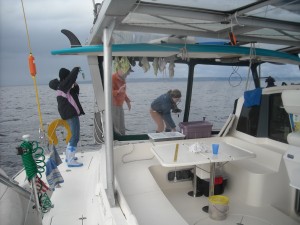OH MY GATO….I FOUND A SAILOR
BLOG:
There is an old sailor tale that tells of a large ship one day caught in the middle of the Ocean. A large wave came over the side and knocked their anchor down into the depths of the ocean. No matter how much the sailors heaved and pulled they could not seem to pull up the anchor, and feared that if they pulled to hard they would make a hole in the bottom of the ocean, and drain out all the water. A brave sailor dove off the bow of the ship with knife in hand, ready to face whatever lay at the bottom of the sea. After a few tense minutes the sailor burst to the surface of the ocean and told the others that he had freed the anchor, and the ship was free to sail. After they had pulled him up onto the deck they asked him how he had freed the anchor. The sailor told them that a giant octopus had grabbed onto their anchor and was playing with it, but he had tied its legs into bowline knots, so it would never bother them again.
Although we didn’t encounter giant octopi on the Gato Verde (http://www.gatoverde.com/), I think this story reviles subtle truths about life out at Sea. First of all as a crew you have to be ready for anything whether it be a sea creature, or just the logistics of where to dock at night. Learning to be ready for anything at anytime takes a while to get use to, but like everything else we learned while on the Gato it seems to apply not only to sailing and science, to life.
One of the most important lessons I took away from the Gato was an understanding of what it takes to live sustainably. It is all too common to go through life unaware of the impact you are making, and the resources you are using. I feel that before my time on the Gato I was somewhat aware of my impact, and attempted to live sustainably, but I did not fully recognize the effect of everything I did. On the Gato we took measurements of the fresh water, sewage, and bio- diesel used. These are things that are easy to take for granted in every day life, but when living on a boat you start to realize just how much water you use, and sewage you produce. We had a water tank that held all our fresh water for dishes, drinking, and cooking with. Our water holding tank was on the port side of the Gato over the left hull. The water level was measured in cm and converted to liters and gallons. It was interesting to see how much water we used everyday. We still used a lot of water per person everyday, so it hard to imagine how much water we use daily when taking showers. The sewage tank was on the starboard side of the Gato near the bow. The sewage system was connected to the heads (bathrooms), which were on both the port and starboard side of the boat. Before the Gato I had not idea of how much sewage 8 people can produce, let alone a city, and how difficult sewage can be to deal with. Captain Todd explained the different types of holding tanks a boat can have, and the different ways to treat them. He had a type 3 system, which was an anaerobic system. He introduced a certain species of bacteria into his system that out competed the bacteria that make sewage smell. It was amazing to think that we had a tiny ecosystem on board the Gato with us. Who knew poop could be so fascinating!
In order to conserve bio-diesel we attempted to sail when the wind allowed. Although we didn’t get many opportunities to sail, it was a fun time when we did. Captain Todd taught us about the different points of sail: close-hauled, beam-reach, broad reach, running, and irons (no go zone). We got to steer the boat on our first cruse tacking down the Strait of Georgia. We learned how to sail right against the irons, without going into irons (60-50*) an ideal angle for sailing. We learned about how to let out the jib and main sail, and how to properly put both away.
As a class we also had to figure out our daily navigation. To do this we had to take a lot into consideration: the weather, sea state, tides, where the whales were, and where we would spend the night. At first this seemed to be a logistic nightmare, but after we created a routine for the navigator it became relatively easy. The hard part of navigating occurred when we had to make important decisions during the day, like if we were going to try and catch the whales.
Boat life is difficult, but extremely rewarding at the same time. Looking back my best memories of the boat involve sitting on the trampoline and just appreciating the sea that surrounded us.




 Twitter
Twitter LinkedIn
LinkedIn Facebook
Facebook